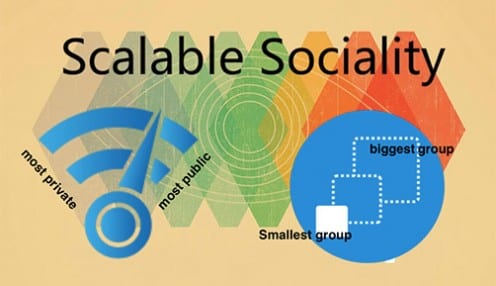What’s our conclusion? Introducing ‘scalable sociality’
By Daniel Miller, on 16 June 2015

Scalable Sociality
Right now we are finishing the last of our eleven volumes from this project, a book which will be called How the World Changed Social Media. Not surprisingly, people are starting to ask about our conclusions. There are of course many of these, and the website will also showcase these ‘discoveries’, but as anthropologists our primary concern is to determine the consequences of social media (or what used to be called social networking sites) for our own core concern which is sociality – the study of how people associate with each other.
We have concluded that the key to understanding this question is through what we will call ‘scalable sociality.’ Prior to social media, we mainly had private and public media.
Social networking sites started with platforms such as Friendster, QZone and then Facebook as a kind of broadcasting to a defined group rather than to the general public, in a sense scaling downwards from public broadcast.
By contrast some of the recent social media such as WhatsApp and WeChat are taking private communications such as telephones and messaging services that were mainly one-to-one and scaling upwards. Often these now also form groups, though generally smaller ones. Also these are generally not a single person’s network. All members of the group can post equally to all the others.
If we imagine two parameters – one consisting of the scale from private to public and the other from the smallest group of two up to the biggest group of public broadcast – then as new platforms are continually being invented they encourage the filling of niches and gaps along these two scales. As a result, we can now have greater choice over the degree of privacy or size of group we may wish to communicate with or interact with. This is what we mean by scalable sociality.
However this is just an abstract possibility. What people actually do is always a result of local norms and factors. In each society where we conducted fieldwork, we saw entirely different configurations of these scales as suits that area.
In our South Indian site these mainly reflect traditional groups such as caste and family. In our factory China site an entirely new society of floating workers create largely new norms of group interactivity including their first experience of true privacy. While in our rural Chinese site the main difference is that it is possible to now include strangers on the one hand and to extend various social ‘circles’ on the other. In our English site people specialise in the exact calibration of sociality that is neither too close, nor too distant.
Nonetheless, all of these are variants that can be understood as exploiting this new potential given by social media for an unprecedented scalable sociality.
 Close
Close





